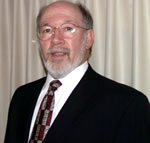 |
Tulane
Engineering Forum
|
|
|
|
|
|
| |
| Opportunities |
| |
| |
| |
| |
Charles W. Williams Charles
W. Williams is a graduate of
the University of North Alabama,
Florence, AL in 1966 with B.S.
degrees in Chemistry and Math.
Immediately following graduation,
he worked for eight years with
Hayes International Corporation
as a support contractor to the
Marshall Space Flight Center,
in Huntsville, AL. Mr. Williams
joined Martin Marietta (now
Lockheed Martin) in 1976 to
support the Design, Development,
Test and Evaluation phase of
the Space Shuttle External Tank
Thermal Protection System (TPS).
Following the successful launch
of the first vehicle, Mr. Williams
was tasked with the assignment
to improve performance and reduce
weight of the External Tank
TPS. Over 1000 pounds weight
savings were realized beginning
with ET-12 through the next
several tanks due to development
of higher performance materials
and refinements in flight environments.
Beginning with the EPA phase
out of CFC's, used as blowing
agents in foams, efforts were
focused on development of materials
compliant with environmental
laws and regulations. Research
work over the last six years
has dealt with continued issues
relating to increased TPS weight
reduction while at the same
time addressing the imminent
phase out of HCFC's used extensively
as blowing agents in TPS foam
systems. Presentation Topic : Modifications to the Space Shuttle External Tank Thermal Protection System to Comply with the New Environmental Laws By: Charles W. Williams
Lockheed
Martin at NASA's Michoud Assembly
Facility in eastern New Orleans
manufactures the External Tank
(ET) for the Space Shuttle.
The phaseout of ozone depleting
substances (ODS) under EPA regulations
has had a major impact on ET
production. The ET requires
a thermal protection system
(TPS) to maintain the quality
of the cryogenic propellants
used to power the Shuttle, provide
protection from aerothermal
and vehicle plume heating environments,
prevent formation of ice on
exterior surfaces, and maintain
structural integrity. The TPS
is a rigid foam that initially
used CFC 11, then HCFC 141b,
as the chemical blowing agent
to provide the critical insulation
and cell structure properties.
Lockheed Martin and NASA began
HCFC 141b replacement efforts
far in advance of the upcoming
1/1/2003 phaseout, but no replacement
has been found that meets performance
requirements. This presentation
illustrates issues with which
the manufacturers and consumers
of insulating foams are faced
due to the ODS phaseout program,
as well as problems unique to
the space program. |

|